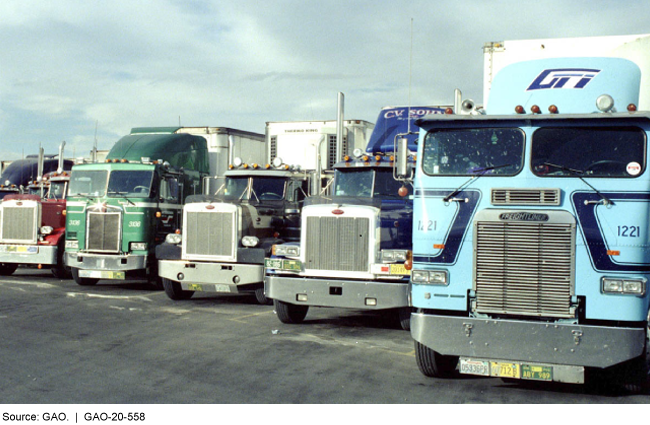Surface Transportation Security: TSA Has Taken Steps to Improve its Surface Inspector Program, but Lacks Performance Targets
Fast Facts
The nation's surface transportation system includes nearly 140,000 miles of railroad track and 4 million miles of roads. It supports nearly 10 billion mass transit trips annually.
The Transportation Security Administration secures, inspects, and assesses the surface transportation system—which may be vulnerable to terrorist and other threats because it is difficult to monitor and secure completely.
TSA has set goals for its inspection program, but it has not set measurable targets to assess how well its security activities are working or to guide needed changes. We recommended that TSA set these targets.

Highlights
What GAO Found
According to the Transportation Security Administration (TSA) Surface Transportation Security Inspector Operations Plan (TSA's plan), surface transportation security inspectors—known as surface inspectors—are to enter key details for program activities in the Performance and Results Information System (PARIS)—TSA's system of record for all surface inspector activities. In December 2017, GAO reported that TSA was unable to fully account for surface inspector time spent assisting with non-surface transportation modes, including aviation, due to data limitations in PARIS, and recommended TSA address these limitations. Since GAO's report, TSA updated PARIS to better track surface inspector activities in non-surface transportation modes.
Transportation Security Administration Surface Inspectors Assess Security of a Bus System

TSA's plan outlines steps to align work plan activities with risk assessment findings. However, TSA cannot comprehensively ensure surface inspectors are targeting program resources to high-risk modes and locations because it does not consistently collect information on entity mode or location in PARIS. According to officials, TSA plans to update PARIS and program guidance to require inspectors to include this information in the system by the end of fiscal year 2020.
TSA's plan outlines performance measures for the surface inspector program, but does not establish quantifiable performance targets for all activities. Targets indicate how well an agency aspires to perform and could include, for example, entity scores on TSA security assessments, among others. By developing targets, TSA would be better positioned to assess the surface inspector program's progress in achieving its objective of increasing security among surface transportation entities.
Why GAO Did This Study
Surface transportation—freight and passenger rail, mass transit, highway, maritime and pipeline systems—is vulnerable to global terrorism and other threats. TSA is the federal agency primarily responsible for securing surface transportation systems.
The FAA Reauthorization Act of 2018 requires TSA to submit a plan to guide its Surface Transportation Security Inspectors Program. The Act includes a provision for GAO to review TSA's plan. This report examines the extent to which TSA's plan and its implementation: (1) address known data limitations related to tracking surface inspector activities among non-surface modes, (2) align surface operations with risk assessments, and how, if at all, TSA ensures inspectors prioritize activities in high-risk modes and locations, and (3) establish performance targets for the surface inspector program. GAO reviewed TSA's June 2019 plan and analyzed data on inspector activities for fiscal years 2017 through 2019. GAO interviewed officials in headquarters and a non-generalizable sample of 7 field offices selected based on geographical location and the presence of high-risk urban areas.
Recommendations
GAO recommends that TSA establish quantifiable performance targets for the surface inspector program's activity-level performance measures. DHS concurred with our recommendation.
Recommendations for Executive Action
| Agency Affected | Recommendation | Status Sort descending |
|---|---|---|
| Transportation Security Administration | The TSA Administrator should establish quantifiable targets for the Surface Transportation Security Inspectors Program's activity-level performance measures. (Recommendation 1) |
Closed – Implemented
The Transportation Security Administration (TSA) deploys Surface Transportation Security Inspectors throughout the country to enforce regulations and assist surface transportation entities with security-related matters through its Surface Transportation Security Inspectors Program. In July 2020, we reported that while TSA measures the performance of the program's various security activities, it had not established quantifiable performance targets to assess the program's progress in achieving its objectives. We recommended that TSA establish quantifiable targets for the Surface Transportation Security Inspectors Program. In August 2021, TSA responded to our recommendation by developing quantifiable performance targets for the program and reported that it is beginning to collect and track data for these targets. For example, one of the performance targets TSA created for its Base Assessment for Security Enhancement activity establishes that participating mass transit and highway operators implement an average of 70 percent of key security measures, including facility access controls and background checks for employees and contractors, among others. These actions should enable TSA to better assess program performance and better identify areas of improvement if targets are not met. Consequently, this recommendation is closed as implemented.
|
